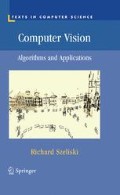Abstract
In this book, we have covered a broad range of computer vision topics. Starting with image formation, we have seen how images can be pre-processed to remove noise or blur, segmented into regions, or converted into feature descriptors. Multiple images can be matched and registered, with the results used to estimate motion, track people, reconstruct 3D models, or merge images into more attractive and interesting composites and renderings. Images can also be analyzed to produce semantic descriptions of their content. However, the gap between computer and human performance in this area is still large and is likely to remain so for many years.
Author information
Authors and Affiliations
Corresponding author
Rights and permissions
Copyright information
© 2011 Springer-Verlag London Limited
About this chapter
Cite this chapter
Szeliski, R. (2011). Conclusion. In: Computer Vision. Texts in Computer Science. Springer, London. https://doi.org/10.1007/978-1-84882-935-0_15
Download citation
DOI: https://doi.org/10.1007/978-1-84882-935-0_15
Published:
Publisher Name: Springer, London
Print ISBN: 978-1-84882-934-3
Online ISBN: 978-1-84882-935-0
eBook Packages: Computer ScienceComputer Science (R0)

